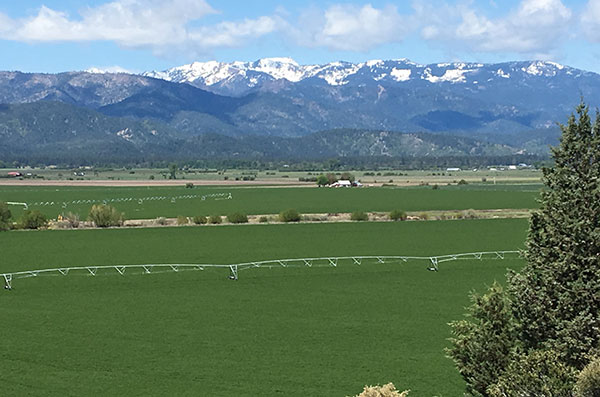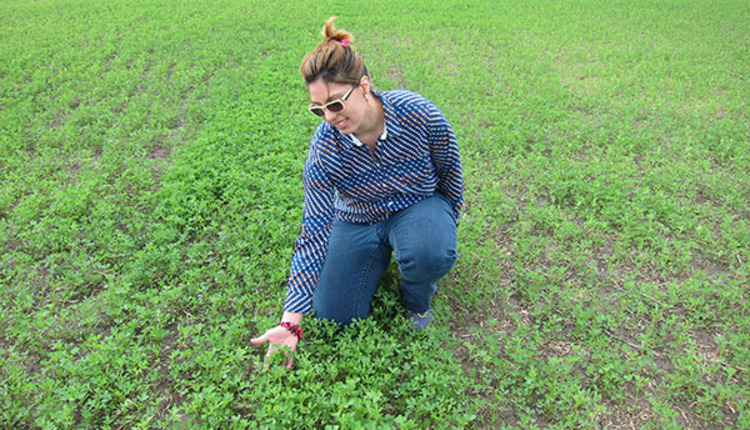
Northern California
Steve Orloff
Farm Advisor/Siskiyou County
University of California-Extension
Winter and spring precipitation in the Intermountain area of northern California and southern Oregon has been much better than the last few years. While this was not the amount of precipitation many had hoped for with an El Niño condition, rainfall in most areas was normal or slightly above, which has improved irrigation water availability for surface irrigation and improved groundwater levels. There should be enough water for most growers to have full-season irrigation.
There have already been some record-high temperatures this spring and, overall, nighttime lows have been significantly higher than a “normal” year. Therefore, the growth of alfalfa and most grass hayfields is ahead of schedule. In some cases, first cutting may be as soon as two to three weeks away. With overall poor prices and a very large price differential between top dairy-quality alfalfa and fair alfalfa, many growers will likely want to cut earlier than normal, if the weather allows, in order to obtain a price premium.
The wetter spring this year has given rise to significant stem nematode damage in many fields. Downy mildew has also been observed in some fields. Alfalfa weevil is showing up with significant damage in some areas and adequate control has been problematic at times. Blue alfalfa aphid was a serious pest last year, but fortunately populations have been extremely low this year; hopefully, this is one insect pest we won’t have to contend with in 2016.


Karla Hernandez
Extension Forage Specialist
South Dakota State University
One of the main concerns as we enter this growing season is alfalfa winter injury and winterkill. In South Dakota, we had a pretty decent winter with some cold temperatures, but, overall, it was fairly mild. The lack of snow cover was one of the main concerns for producers as alfalfa plants can die if exposed to extremely cold temperatures, which are not uncommon for us.
While driving through the eastern part of the state, alfalfa fields have typically not shown much damage. However, newly seeded alfalfa stands that had a later cutting in 2015 have been showing some mild winterkill. The late cutting might not have allowed enough regrowth and storage of carbohydrates into the root system.
At the start of this 2016 growing season, we have had normal levels of moisture and precipitation that have helped forages to start their growth. New stands have been planted since mid-April and will continue as weather permits. Areas of concern this growing season are: (1) moisture and rainfall patterns, (2) insect infestations such as alfalfa weevils and potato leafhoppers, (3) maintaining stem density, (4) overall biomass production, and (5) improving overall general forage quality for all feedstock forages.


Phil Kaatz
Forage and Field Crop Educator
Michigan State University-Extension
Winter was quite mild in Michigan to the delight of many alfalfa growers from north to south. March and early April had numerous days with precipitation (some liquid and some solid) and totals were above average for both days and amounts. This prevented most fieldwork from getting done for much of the state.
Many of the alfalfa stands are starting to show good growth with very little winterkill, although there have been a few reports of flooded fields that killed alfalfa earlier this spring. The growing degree days (alfalfa - base 41°F) range from 77 in the Upper Peninsula to 388 in the southwest (all regions except the UP are above the past five-year average). Based on temperature, plants range from emergence to 8 to 10 inches tall, depending on location.
Hay inventories are quite good across the state. Much of the best quality hay was sold early leaving the good to below average hay available going into the spring season.
Planting intentions for alfalfa this spring are expected to be the same or slightly higher than a year ago. In some parts of the state, wet spring weather the last two years has hurt the new seedings and so stands have been less than ideal. Subsequently, I expect those fields to be terminated and planted to row crops if they lack the number of plants or stems per square foot for maximum yield.


